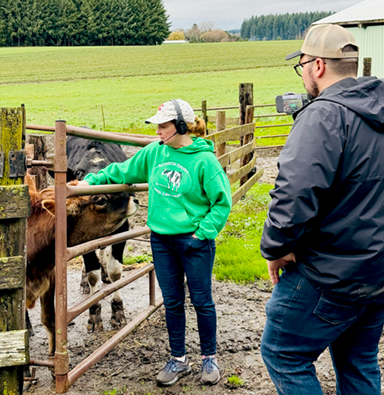Reconnecting with Our Roots: Reviving Agricultural Education in Washington County

By Casey Blake, Washington County Programs Coordinator, Oregon AITC
Over the last few decades, Washington County has gone through a transformation and shifted from its historically agricultural roots. As development for housing and commerce replace farmland, a growing chasm from our agricultural history widens. This shift poses a significant challenge: How do we ensure that the next generation understands the importance of agriculture in a region where urban development increasingly overshadows our farming roots?
Oregon Agriculture in the Classroom Foundation (AITC) is helping bridge this gap by bringing agricultural education into Washington County classrooms, fostering a connection to something that makes our state very special. With less direct exposure to farming, many students in Washington County grow up with an incomplete understanding of where their food comes from, the natural resources that exist around them, and the environment that makes Oregon amazing. A detachment from agriculture is a stark contrast to the county’s historical reliance on farming and can have long-term implications for community values and environmental stewardship.
Oregon Agriculture in the Classroom is dedicated to reversing this trend by reintegrating agricultural education into the lives of students. By providing hands-on learning opportunities and engaging educational resources, AITC helps students reconnect with their agricultural roots. AITC offers a wide range of programs designed to make agriculture accessible and engaging for students including comprehensive lesson plans, virtual field trip opportunities, educator workshops featuring a variety of agriculture topics, and an annual Literacy Project, to name a few things.
Lessons are crafted to meet educational standards while providing practical, hands-on learning experiences. For instance, students might study the lifecycle of a plant by growing their own vegetables in classroom gardens, observing the process from seed to harvest.

share in the classrooms.
A vital component of AITC’s approach is facilitating interactions between students and local farmers. We offer numerous virtual farm field trips every school year, allowing students the chance to interact with the people who grow their food and learn about the daily challenges and rewards of farming. These experiences demystify the agricultural industry and highlight its relevance.
Every Spring, AITC hosts a Literacy Project which connects students to the agricultural community. The project entails reading the featured agriculturally-themed book and leading an activity with the students, reinforcing the message or theme of the book. The book and activity change from year to year and participating schools receive both a copy of the book and a bookmark for every student. This year’s book, Up in the Garden, Down in the Dirt, has been shared with over 150 classrooms in Washington County. At the beginning of May, students at Cedar Mill Elementary School participated in a school-wide reading. This event allowed students to learn more about agriculture and engage with additional AITC resources.
So how can you use these resources to get involved in Oregon Agriculture in the Classroom Foundation? Community support is crucial for the success of AITC. This organization is a small non-profit which exists through the support of volunteers, donors, and local businesses. Thanks to funding from the Tualatin Soil and Water Conservation District, there is dedicated personnel to serve just Washington County Classrooms.
If you want to reinforce this learning with kids in your family over the summer, visit oregonaitc.org and check out the Resources tab or scroll to the bottom of the home page to sign up to receive monthly programming updates. There are also opportunities to volunteer to help the AITC mission. Together, we can reconnect with our agricultural roots and ensure that the next generation understands the vital role of agriculture, even in an increasingly urban landscape.





